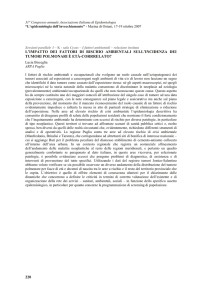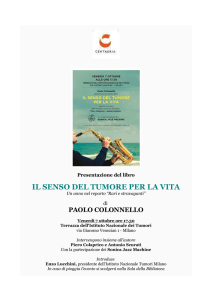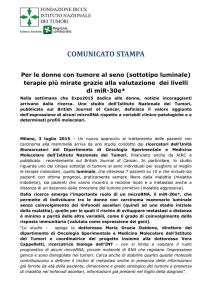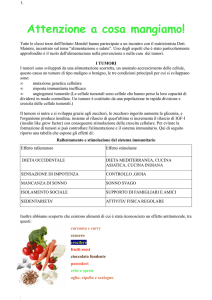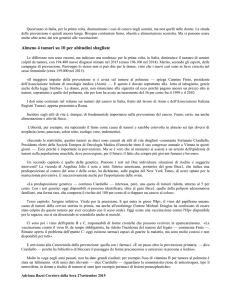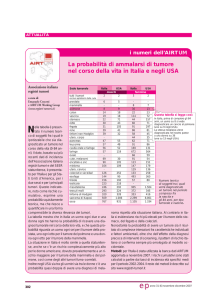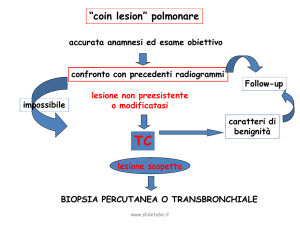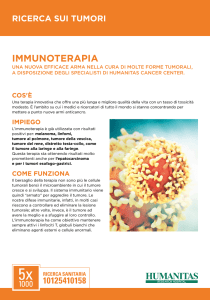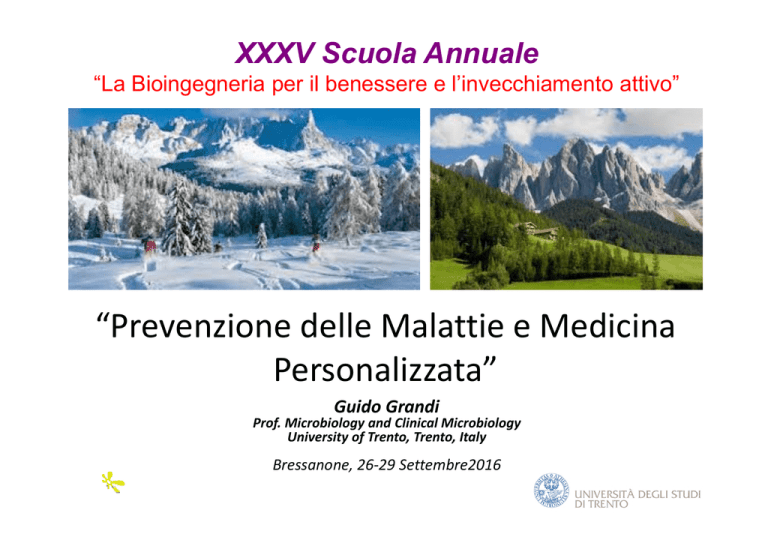
XXXV Scuola Annuale
“La Bioingegneria per il benessere e l’invecchiamento attivo”
“Prevenzione delle Malattie e Medicina
Personalizzata”
Guido Grandi
Prof. Microbiology and Clinical Microbiology
University of Trento, Trento, Italy
Bressanone, 26-29 Settembre2016
Leading causes of deaths worldwide
Infections
(including parasites
and COPD)
Cancer
0.5 Mil. caused by
Streptococcus
The fight against infectious diseases
•
Prevention
- Hygiene and personal behavior
- Vaccination
•
Therapy
- Antibiotics
The importance of hygiene and personal
behavior: the “Black Death” case
The importance of hygiene and personal
behavior: the “Black Death” case
Over 200 Millions deaths attributed to Yersinia pestis throughout
recorded history
In industrialized countries plague is extremely rare (less than 13
cases/year between 1984-1994 in the USA)
The dawn of immunoprophylaxis
•
•
•
First attempt to prevent an infectious disease: inoculation
of the smallpox (variolation), reported in China, AD 1000.
Scabs from mildly affected patients, stored for >1 month,
ground up with Uvularia grandiflora in a 4:1 ratio and
inoculated intranasal.
Lady Mary Montagu introduced the practice in Great Britain
in 1715. She pretended to have her 5 year old son
inoculated and when back from Constantinople, during the
1721 epidemic, she convinced others to “inoculate”
children
Early variolation procedures
led to death in approximately
1-2% of the immunized
people. This was considered
acceptable
The origin of vaccination
•
•
During the last decades of the 18th century, smallpox was
rampant in Europe. At that time was observed that
milkmaids were selectively spared by smallpox and this
was related to the mild pox infection they acquired from
cows
In 1796 Edward Jenner immunized an eight year old boy
with cowpox and later challenged the child with smallpox
(variolation)
The first uses of attenuated bacteria as
parenteral and oral immunizing agents
Edward Jenner
(1749 - 1823)
In the last quarter of the 19th
Century bacteriology became a
science. One after another, bacteria
came to be revealed as etiological
agents of important human diseases
(cholera, typhoid fever, plague,
diphtheria, tuberculosis, etc.).
The ability to obtain pure cultures
paved the way for the development
of vaccines.
Louis Pasteur (1822-1895)
Vaccines:
The Greatest Revolution in the History of Health Care
Max. N° of cases
(year)
N° of cases in
2001
Reduction
48,164 (1901-1904)
0
100%
Poliomyelitis
21,269 (1952)
0
100%
Diphtheria
206939 (1921)
2
99.99%
Measles
894134 (1941)
96
99.99%
Rubella
57686 (1969)
19
99.78%
Mumps
152209 (1968)
216
99.86%
Pertussis
265269 (1934)
4788
98.20%
H. influenzae
20000(1992)
242
98.79%
Tetanus
1560 (1923)
26
98.44%
Disease
Smallpox
Vaccination remains the medical intervention
with the highest impact on health
Drop in death rate for diseases prevented or treated with innovative
medicines (pharmaceuticals)
1965 – 1999
Infectious Diseases
(polio, measles, Hib, D,, T,, Pertussis, etc)
VACCINATION
- >97%
THERAPEUTICS
Rheumatic fever and
rheumatic heart disease
-75%
Hypertensive heart disease
- 67%
Ulcer of stomach and duodenum - 61%
Ischemic heart disease
Source: EFPIA 1999 – 2002
- 41%
Vaccination challenges
1.INFECTIOUS
The need forDISEASES/PATHOGENS
more vaccines (against
WITHOUTofVACCINES
diseases
the poors)
VIRAL
BACTERIAL
PARASITIC
HIV
Cytomegalovirus
Herpes simplex
Genital herpes
HCV
Parainfluenza
Respiratory syncytial virus
Rotavirus
Ebola virus
Papillomavirus
Coronavirus (SARS)
Leprosis
Gonorrhea
Urinary infections
Enterotoxigenic E. Coli
Streptococcus pyogenes
Streptococcus mutans
Streptococcus agalactiae
Pseudomonas
Shigella
Campylobacter
Lyme disease
H. pylori
S. aureus
Chlamydia
MenB
Klebsiella
Klebsiella
Ascaris
Malaria
Schistosomes
Hookworm
Trichuris
Filarias
Giardia
Leishmania
GENOMICS AND VACCINE DISCOVERY
REVERSE VACCINOLOGY: THE RATIONALE
IF MICROBIAL PROTEIN ANTIGENS CAPABLE OF ELICITING
PROTECTIVE IMMUNITY DO EXIST, THEY MUST BE ENCODED BY
GENES SITTING SOMEWHERE IN THE MICROBIAL GENOME
GENOME SEQUENCE
HIGH THROUGHPUT CLONING AND EXPRESSION
IN VITRO AND IN VIVO ASSAYS FOR VACCINE
TARGET IDENTIFICATION
REVERSE VACCINOLOGY
The MenB Vaccine
600 potential vaccine candidates
identified by in silico analysis
350 proteins successfully expressed
in E.coli
344 proteins purified and used
to immunize mice
18
months
355 sera tested
91 novel surface-exposed
proteins identified
29 novel proteins
have bactericidal
activity
Registered
in Europe
5 highly conserved
antigens
5 vaccine candidates
(Pizza et al., Science, 2000)
24
months
The Holy Grail of Vaccinology:
Have a look at the genome, click your mouse and say
this %
and %. this!
this %
..
Is the analysis of “Human Pathogen Protectome”
the right path to the Holy Grail?
Altindis et al., Mol. Cell. Proteomics (2014)
Vaccination challenges
2. The aging society
The fight against infectious diseases
•
Prevention
- Understanding of the biology and pathogenesis
- Hygiene and personal behavior
- Vaccination
•
Therapy
- Antibiotics
LIFE EXPECTANCY (YEARS)
Impact of antibiotics on life expectancy
Beginning of antibiotics era
(penicillin)
Therapy for infectious diseases
1. The Challenge of drug resistance
Therapy for infectious diseases
2. The Challenge of new drug discovery
The fight against cancer
•
Prevention
•
Early diagnostics
•
Therapy
I tumori hanno accompagnato gli esseri viventi
sin dalla loro comparsa sulla terra
• L’ analisi tomografica di oltre 10.000 campioni di vertebre di dinosauro
vissuti più di 70 Milioni di anni fa ha evidenziato l’esistenza di tumori
benigni e nello 0,2% dei campioni, di tumori metastatici.
• I più antichi casi documentati di tumore metastatico nell’uomo sono
quelli di un Re Scita e di un Egiziano Tolemaico risalenti
rispettivamente al 2700 e 2200 avanti Cristo. Utilizzando moderne
tecniche microscopiche, proteomiche e tomografiche sui campioni
ossei del primo e sulla mummia del secondo, è stato dimostrato che
entrambi erano deceduti a causa di metastasi di tumore alla prostata
«Caso 45»
«patologia che si manifesta
con la presenza sul seno
di una massa fredda al tatto,
sporgente e diffusa,
e per la quale nessun
trattamento terapeutico
può avere successo».
La prima descrizione medica del tumore e’ ritrovata nel
“Papiro di Edwin Smith», risalente al 1600 AC, descrizione attribuita al
medico Egizano Inhopet vissuto tra il 3000 ed il 2600 AC
L’uomo ha preso piena consapevolezza
delle malattie tumorali negli ultimi 150 anni
Dati USA
2006/2008
1940
1770 1870
uomo
donna
80
60
40
20
0
Life Expectancy (years)
Life Expectancy Curve
2015
1990
Cancer and Cancer Therapy
• Globally, cancer claimed an estimated 7.6 million lives in 2008
• Incidence of cancer-related death has been declining over the last 20 years
but future trend is uncertain due to prolonged life expectancy and increase of
obese population. It has been predicted that cancer-related death could
double the 2008 number by 2030
• The Milken Institute estimates that in the United States (US) alone, a 1%
reduction in cancer mortality has an economic value of $500 billion
Il 12 Febbraio 2016, nel suo discorso agli
Stati dell’Unione, il Presidente Barak Obama
ha lanciato il programma «moon shot»
Obiettivo del programma:
«For the loved ones we have lost, for the
family we can still save, let’s make
America the country that cures cancer
once and for all».
Verra’ raggiunto l’obiettivo del
“moon shot program”?
The fight against cancer
•
Prevention
•
Early diagnostics
•
Therapy
Prevenzione dei tumori: cenni storici
«De morbis artificum diatriba» (1713) Bernardino Ramazzini
Relativamente al tumore del collo dell’utero, Ramazzini riportava come l’incidenza
Del tumore al collo dell’utero fosse estremamente più bassa nelle suore rispetto alle
donne sposate, ipotizzando che l’attività sessuale ne favorisse l’insorgenza (HPV)
Nel 1761, John Hill evidenziava i rischi associati alla masticazione del tabacco
«Nessun uomo dovrebbe avventurarsi in questa pratica a meno che non abbia
evidenze di essere resistente ai tumori; ma nessun uomo può asserire
di avere tale evidenze».
Nel 1775 Percivall Pott assoccio’ l’insorgenza del tumore allo scroto dei giovani
«spazzacamini» al deposito della fuliggine tra le pieghe cutanee
Prevenzione dei tumori
A) Tumori di origine virale e batterica
1.
2.
3.
4.
tumori epatici: 80% dei casi dovuti a infezioni da HBV e HCV
tumore al collo dell’utero: infezione da HPV
20% dei tumori della cavità orale: infezione da HPV
Tumore allo stomaco: infezione da Helicobacter pylori
Modalita’ di prevenzione:
- Vaccinazione (HBV e HPV)
- Farmaci anti-HCV, antibiotici contro H. pylori
B) Tumori derivanti da esposizione ad agenti cancerogeni
1. tumori al polmone: 85% causati dal fumo
2. melanoma della pelle: esposizione raggi UV
Modalita’ di prevenzione:
L’astensione dal fumo (si eviterebbero 2 milioni di casi di tumore/anno e 0,8-1
milioni di decessi/anno);
Protezione da della pelle dall’esposizione prolungata ai raggi solari e astensione
da pratiche abbronzanti mediante esposizione a raggi UV. (si eviterebbero 2
milioni di tumori cutanei)
C) Tumori derivanti da altre cause
Obesità, inattività fisica e non corretta alimentazione
E’ stato calcolato che nel 2012 in USA questi fattori sono stati responsabili di
circa un terzo dei 577.190 casi di decesso tumore-associati.
The fight against cancer
•
Prevention
•
Early diagnostics
•
Therapy
Importanza della diagnosi precoce
DIAGNOSI PRECOCE
Ispezione degli organi e tessuti alla ricerca di alterazioni istomorfologiche sospette.
1. Melanomi o stadi pre-cancerosi della pelle
Analisi morfo-istologica (nei, nevi, etc.)
2. Tumore della mammella
Mammografia: esame radiologico che fornisce informazioni sulle strutture delle
ghiandole e sulle eventuali alterazioni della mammella.
3. Tumore del collo dell’utero
PAP test: prelievo di cellule dalla cervice mediante il quale è possibile
identificare eventuali anomalie cellulari
4. Tumore colon-retto (CRC)
Ricerca di sangue occulto nelle feci.
L’American Cancer Society ha recentemente pubblicato le statistiche relative al
periodo 1990-2015
I dati indicano che grazie alla diagnosi precoce, la mortalità associata al tumore
al seno è scesa del 39%, quella per i tumori al colon retto del 45% e quella del
tumore alla cervice di oltre il 50%.
Effetto della diagnosi precoce sulla mortalita’
colon
Effetto della diagnosi precoce sulla mortalita’
seno
utero
colon
DIAGNOSI PRECOCE DEI TUMORI
PROSPETTIVE FUTURE
1. Identificazione e sequenziamento di DNA circolante
2. Isolamento e caratterizzazione delle cellule tumorali circolanti
3. Isolamento e caratterizzazione degli esosomi
Purificazione e sequenziamento del DNA circolante
Mutation Frequencies in major cancers
Vogetstein B et al.,
(2013) Science, 339,
1546
Identificazione di cellule tumorali circolanti
Identificazione di cellule tumorali circolanti
Identificazione di cellule tumorali circolanti
Identificazione di Esosomi circolanti
Identificazione di esosomi circolanti
The fight against cancer
•
Prevention
•
Early diagnostics
•
Therapy
Ippocrate:
«[Di fronte ad un caso di tumore meglio] non intervenire in quanto, se non trattato,
il paziente vive più a lungo».
Leonardo Bertipaglia (influente chirurgo del XV secolo):
«Coloro i quali pretendono di curare il cancro incidendo, alzando e estirpando la
massa tumorale, come unico risultato hanno quello di trasformare un cancro non
ulceroso in uno ulceroso».
William Bainbridge «The Cancer Problem» (1918, pagina 2)
«Durante i secoli RR i campi e le foreste, le botteghe dei farmacisti
e i templi sono stati saccheggiati alla ricerca di qualche strumento
in grado di alleviare questa malattia intrattabile.
Quasi ogni animale vivente ha dovuto pagare il suo contributo
in peli, pelle, denti, unghie, timo, tiroide al vano tentativo dell’uomo
di trovare qualche rimedio [contro i tumori]».
Terapia Tumorale
1. Farmaci capaci di bloccare la crescita delle cellule tumorali
Esempi:
Gleevec: leucemia mieloide cronica (CML)
Iressa e Tarceva: Tumori al polmone con mutazioni di EGFR
Velcade: Inibitore del proteasoma Mieloma multiplo
1. Immunoterapia dei tumori
Anticorpi che attivano la risposta immunitaria (check point antibodies)
Medicina personalizzata
Le sfide dell’Immunoterapia Tumorale
1. Contrastare l’ambiente immunosoppressivo
2. Identificare antigeni tumore-specifici
Mechanism of action of checkpoint blocking mAb
Examples of therapeutic activity of checkpoint
blocking mAb
Lung tumor
Brain tumor
Immune Checkpoint Inhibitors
PD1 inhibitors
Pembrolizumab (Keytruda)
Nivolumab (Opdivo)
melanoma of the skin, non-small cell lung cancer, kidney cancer, head and
neck cancers, and Hodgkin lymphoma. They are also being studied for use
against many other types of cancer.
PD-L1 inhibitors
Atezolizumab (Tecentriq)
bladder cancer, and is also being studied for use against other types of cancer
CTLA-4 inhibitors
Ipilimumab (Yervoy)
This drug is used to treat melanoma of the skin. It is also being studied for use
against other cancers.
Personalized Medicine
Adoptive T cell transfer in Tumor Therapy
Personalized Medicine
Adoptive T cell transfer in Tumor Therapy
“Proof-of-concept” of vaccination with mutationderived neo-epitopes
Kreiter et al., Nature, 2015
Bacterial Outer Membrane Vesicles (OMVs):
Vaccines with Built-in Adjuvanticity
OMV composition
Periplasmic proteins
Lipoproteins
Outer membrane proteins
Secreted proteins/toxins
Protective antigens
LPS
Lipopeptides
Peptidoglican
Others (?)
Adjuvants (PAMPs)
VACCINES WITH BUILT-IN ADJUVANTICITY
Bacterial Outer Membrane Vesicles (OMVs):
Vaccines with Built-in Adjuvanticity
Pathogen-derived OMV vaccines
Genetically modified OMV vaccines
- Neisseria meningitidis B
- Vibrio cholerae
- Burkholderia pseudomallei
- Bordetella pertussis
- Brucella melitensis
- Escherichia coli
- Francisella tularensis
- Salmonella typhimurium
- Porphyromonas gingivalis
- Neisseria meningiidis B OMVs
overexpressing FHbp protective antigen
- Escherichia coli OMVs carrying different
heterologous antigens
- Salmonella typhimurium OMVs expressing
Steptococcus pneumoniae PspA
Testing OMV platform for cancer vaccines
B16F10EGFRvIII
Cell line
Gene mutation
creating a CD4/CD8 T cell
neoantigen
C57 imbred mice
EGFRvIII
Engineered OMVs
2
1
EGFRvIII
CD4/CD8 T cell
neoantigen
3
Immunization with vIII-OMVs, CD4/CD8-OMVs
vIII-CD4/CD8-OMVs and challenge with B16vIII Cell line
Additive/Synergistic effect of EGFRvIII and CD4/CD8 epitope
vIII-OMVs
CD4/CD8-OMVs
vIII-CD4/CD8-OMVs


